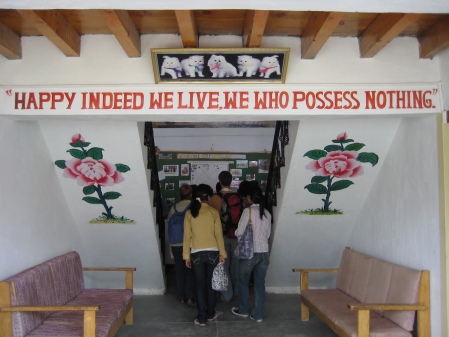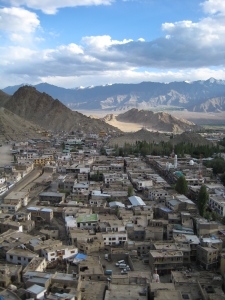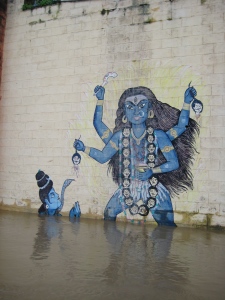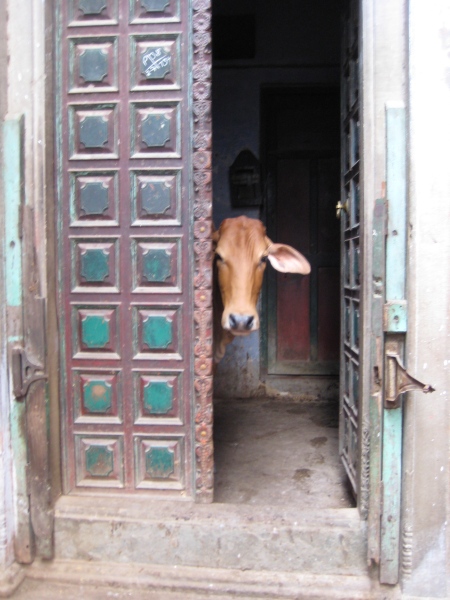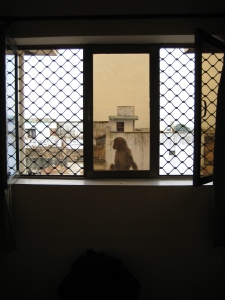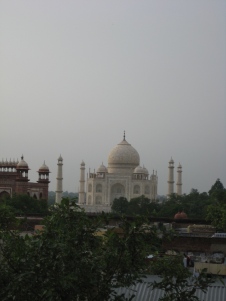I got back from a 2-day trip to the Nubra Valley today. This was accomplished in a “taxi” (in this case a white 4 X 4) that took us out of Leh and over the highest motorable pass in the world, Khardung La. It was somewhere about 18,000 feet up. Oh, that reminds me. When I said Leh is over 3000 feet above sea level, I should have said 3000 METERS. Pesky metric system!
Who is us? Us was me and my three travel friends, all of whom happen to be exceedingly mellow-tempered Israelis in their early thirties (in contrast to the swarms of Israelis fresh out of the army that clog the streets of Leh walking around in their clingy yet billowy “pirate pants”). One part of the trio was a couple (Roee and Netta) and the other was another solo traveller (Yiftah). We found each other at our guest house and somehow, seemingly effortlessly, soon found ourselves wedged together in the taxi, wending our way up the Himalayas to Khardung La.
The trip to the Nubra Valley takes about 5 hours, the length resulting from the amount of winding that must be done to get up and down each mountain. There was a satisfying rhythm to the drive, as we wound our way above Leh, moving away from it and then back towards it, only at a much higher vantage point. It felt like being inside the mechanism of some gigantic scenic clock.
When we reached the pass we said goodbye to the view of Leh. Disparaging remarks were made (by me) about the cleanliness of the glaciers near Khardung La (they were grey in some spots). Roee suggested I volunteer to scrub the glacier.
The pass was like a high-altitude party in the morning. People got out of their taxis and walked to the top of the hill where prayer flags hung. I rang the bell at the little stupa. We took pictures in front of the Khardung La sign and I told Yiftah that I wanted a picture with the Sikh soldier. His navy blue turban would have looked so cool against the aquamarine-blue sky. But I wussed out and couldn’t approach him. Perhaps the memory of the Sikh soldier who tried to politely hit on me at the Delhi airport was stopping me (How long you stay India? Have you been to Golden Temple? Do you have a friend?). Or perhaps I felt a pang of shame for exploiting the man’s religious garb for its aesthetic value. Yiftah took a picture of me by myself in my all-orange outfit (I’d not done laundry for a while).
After we crossed the pass the landscape changed. From the dusty raw umber of Leh the mountains turned to a filmy pale green. The shapes and colors looked like Connemara or the Scottish Highlands. We could see down into a valley with a shallow river, and spotted some lumbering animals that Netta and I both hoped were yaks, but were more likely just hairy black cows. Near the cattle, groups of nomads huddled around their lunches at the side of the road.
After a while the mountains changed again into mesa-like formations, again yellowish but less craggy and wrinkly than Leh. We spotted a prairie dog-like animal standing at attention near the side of the road. This was cause for much excitement for me and Netta, by now clearly the only ones inspired to squeal over novel beasts.
We stopped in a small army station for a snack and some tea. I had some Indian Cheetos (they’re called Kur-kure….Cheeto in form, spicy like a samosa…in other words, the perfect junk food). I paid with a 500 rupee note. This can be dodgy because people seem to never have change, so I was a bit regretful I didn’t have a smaller bill. But never fear! My waiter came back with a wad of bills…and three sticks of bubble gum. I got change in bubble gum. I think that is incredible.
The toilet cost 5 rupees so I went down behind the river bank instead. A line of perhaps 40 Indian soldiers stood behind barbed wire across the street as Yiftah pointed me to the spot that he’d found for ideally discreet outdoor bathrooming. They all wore the same bemused expression. When I emerged a minute later from behind the bank the soldiers were all beaming, literally all wearing the same expression. I sensed they wanted some reaction from me. I addressed the soldiers: “Did you enjoy that?” Then, as though they all shared the same emotional timing, they all laughed in the exact same way. It must be boring to be a soldier in Northern India.
We reached the Nubra Valley in late afternoon, stopping in Diskit for lunch. From the restuarant’s second floor we watched an old woman set up an informal vegetable market on the cement base of a roundabout sign. Her face had more wrinkles than the mountains in Leh but she had the mannerisms of a little girl. We watched her for many minutes with endless commentary.
I drank some curd at lunch that I probably shouldn’t have, but I am still alive!





 Posted by maloneki
Posted by maloneki 